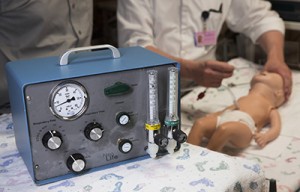BYU Students Saving Lives
Engineering students at Brigham Young University have developed an inexpensive ventilator system for infants in developing countries who die every year from a lack of oxygen. Thanks to a $20,000 grant from John Krupa, a local philanthropist, the project was able to go through two cycles and is now ready for its next phase.
According to the World Health Organization, about 1 million sick or premature newborns in third-world countries die every year due to lack of oxygen. Mortality rates for infants in developing nations are high because health care workers don’t have the equipment of developed nations. The revolutionary ventilator these engineering students have developed will help save thousands, if not hundred of thousands, of lives in those countries.
A typical newborn intensive care unit in the United States has a ventilator that gives oxygen to affected infants continuously until they no longer need breathing assistance, but these units cost about $40,000 and are in short supply in third-world countries. Parents in developing countries with infants needing oxygen must often tirelessly squeeze a hand-pumped ventilator 24 hours a day. If they pump too slowly, the infant could be left with brain damage, too fast and the lungs could pop.
“You see people sitting in the corners of clinics trying to breathe for their baby, trying to stimulate them, and trying to do whatever they can do to keep them alive,” said Ken Richardson, a neonatologist at Utah Valley Regional Medical Center. “It’s heartbreaking.”
The project was completed by twelve students with several professors and doctors who acted as consultants. The device is revolutionary because it can be produced for around $500 – much more affordable than it’s $40,000 counterpart. Each unit has a life span of about two years, which is important for cash strapped medical clinics in the developing world. It doesn’t have the bells and whistles of a typical ventilator, but the device will assist in decreasing infant mortality around the globe.

The device will be saving lives in a matter of months, after appropriate testing is complete. Dr. Erick Gerday, a neonatologist involved in the project, has targeted the Philippines and then parts of Africa as first implementation locations, thanks to contacts he has developed through his work with LDS Charities. But right now, the project is at a standstill.
Spencer Ferguson, one of the students who helped develop the prototype, expressed his frustration with where the project currently stands.
“We have a device that can save hundreds of thousands of lives, and it’s just sitting here, doing nothing.”
It’s just sitting there because there is a lack of funding. Without additional funds the students aren’t able to have their device tested, produced or shipped out to countries and clinics who desperately need devices like this one. The testing alone will cost about $25,000 dollars at the University of Utah.
Krupa, the team’s sponsor, has already received interest from several nonprofit organizations, including the Bill & Melinda Gates Foundation and LDS Charities, to fund the production of thousands of units to be donated to countries in need. But to get to that stage the students have set up a website to gather the necessary funds to go through testing. As of today, May 29, 2014, the team has collected $870 of the $25,000. Click here to learn more about the project.


